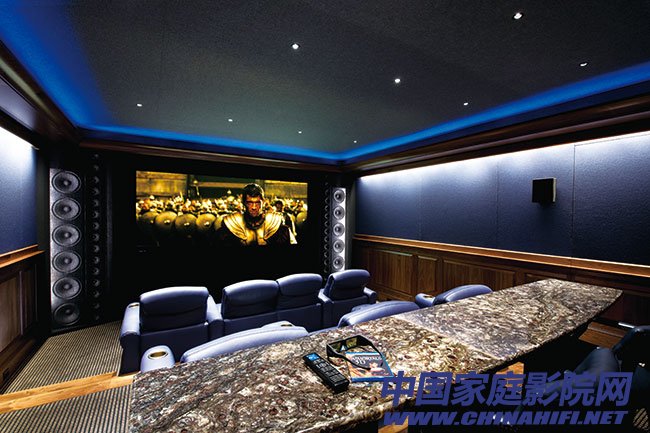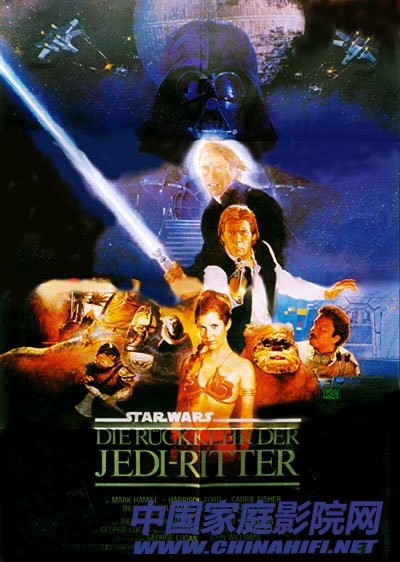
THX
I think the beginning of the modern home theater should be counted from the introduction of the THX® standard. I wonder if everyone agrees.
Speaking of the well-known THX, George Lucas and Tomlinson Holman, after years of preparation, finally launched the first Star Wars film produced in THX standard in 1983: "The Return of the Jedi", which is actually his The third Star Wars movie.

The original intention of the THX standard was to improve the performance of video playback in commercial theaters. As long as the film is produced and played in accordance with the THX standard, the audience is brought into the complete story experience, as was originally created in the film studio.
Then, when THX completed the transformation of the entire film industry, it naturally took the target to the newly emerging home theater market at the time, in 1991. At this time, there is no authoritative standard for home theater, and the family viewing environment is of course more complicated and less effective than commercial cinema. Considering how to cut into the home theater field has become the first thing THX needs to consider. At this time, Ambridge, which had just replaced the top management and was determined to enter Hi-Fi from the home theater field, threw an olive branch with THX, which is also the new home theater. The two are determined to work together to launch an A/V amplifier like the home theater control hub.
In 1994 , the first THX-certified home theater amplifier was introduced - Onkyo's TX-SV919. To date, Onkyo is still the company with the closest cooperation with THX.
Dolby Digital 5.1
Speaking of the famous Dolby Laboratories, no one knows, this company founded in 1965 has been working on sound processing and coding compression. It can be said that there is no modern sound film without Dolby. If THX is committed to how to get good movie playback for 20 years, then Dolby is committed to how to encode, store, transmit and decode sound for 40 years.
Prior to 1992, Dolby's surround sound movie tracks were stored on 35 mm film in a 2-channel analog format and restored to the left, center, right, and back four channels by matrix. With the return of Batman, the release of the classic Batman film directed by Tim Burton, a new audio format is on the stage of history, it is Dolby Digital (also known as AC-3). This is also the first 5.1-format audio track with digital encoding, and the cinema sound has entered the digital age.
With the home LD with Dolby Digital format audio tracks and more and more DVD movies, Onkyo has followed the trend and launched the world's first TX-DS939 amplifier that supports Dolby Digital decoding.
7.1- channel home theater
More channels have always been pursued by sound producers, and more channels mean more surround information, a stronger surround and a clearer sound surround track. Based on Dolby Digital 5.1, Dolby Laboratories developed with THX Lucasfilm and launched Dobly Digital Surround EX in 1999. The first film produced in this format may have been guessed, that is, the fourth Star Wars that was released that year: "Phantom of the Crisis."
The main feature of this format is the addition of a surround back channel in addition to the basic 5.1 channel. This channel can also be restored to the left and right surround back channels by the matrix, resulting in a 7.1-channel output.
The DVD version of the subsequent Star Wars movie was taken for granted with this format. What to do, the home theater certainly has to keep up with the pace of the commercial theater. In 2000, Onkyo launched the world's first 7-channel power amplifier TX-DS989 that supports Dolby Digital Surround EX. Since then, the home theater has entered the 7-channel era. .
HDMI 1.3
do you know? Before 2007, all the sounds you heard were compressed in a lossy compression format. Due to the technical limitations of the era of Dolby Digital, the DTS standard, the compression and storage of sounds used lossy compression techniques, sacrificing some frequency segments and details that are insensitive to human ears, in exchange for smaller capacity and smaller transmissions. bandwidth. The DVDs that were popular in the market were able to accommodate audio tracks in these formats. The optical or digital coaxial ports of the disc players were able to transmit audio in these formats to the amplifier for decoding. Even so, the audio track capacity of a full-code DTS (1.5 Mbps) movie can reach about 1 G. The film has to be released in the form of D9, and the upgrade of technology and media is imminent.
With the Blu-Ray Blu-ray Disc gaining the upper hand in the battle with the next generation format of HD-DVD, the standard of the HDMI interface has also been upgraded to 1.3. From here, DolbyTrueHD, DTS-HD Master Audio, which use the lossless compression format to create and store high-definition audio tracks, can be transmitted to the amplifier through the HDMI interface for the first time, and decoded by the most powerful cinema amplifier, and the original movie sound effect. The details are finally brought to the audience. By the way, DTS-HD Master Audio has a maximum bit rate of 24.5 Mbps, which is 16 times that of ordinary DTS. Such a large amount of information will be a huge test for the processing power of the power amplifier.
In 2007 , the first HDMI 1.3 ready home theater amplifier, Onkyo's TX-SR805 came out.
HQV
Many people think that the popularity of 1080p Blu-ray movies, even the arrival of 4K movies, is no longer useful. This is actually a one-sided view. In real life, you still have a lot of old video equipment, such as DVD players, old game consoles, even video recorders, and some nostalgic videos on storage devices. It is a non-HD video format, and even many use interlaced scanning to record storage. When playing on a device without an HQV processing chip, blurring of the picture occurs, and the edges of the outline of the object are jagged, and the phenomenon of deinterlacing, commonly known as "drawing", seriously affects viewing. After the HQV chip processing, these problems in non-HD video have been solved, and the resolution can be increased to 1080P HD level. Even with high-definition video signals, HQV can perform certain noise reduction, correction and enhancement on the screen for optimal viewing.
Speaking of HQV, it is also a fateful technology from Silicon Optix, which was acquired by IDT in 2008 and finally transferred to the current chip giant Qualcomm in 2011. So now HQV® is a patented technology of Qualcomm.
HQV (full name Hollywood Quality VideoTM), as its name suggests, is a technology dedicated to recreating the quality of Hollywood films. It is also a natural matter to apply this technology to home theaters. In 2007, Onkyo's TX-NR905 This technology is equipped at one time.
750V DC Power Supply,High Measurement accuracy power supply,SCPI commands web GUI power supply
APM Technologies (Dongguan) Co., Ltd , https://www.apmpowersupply.com